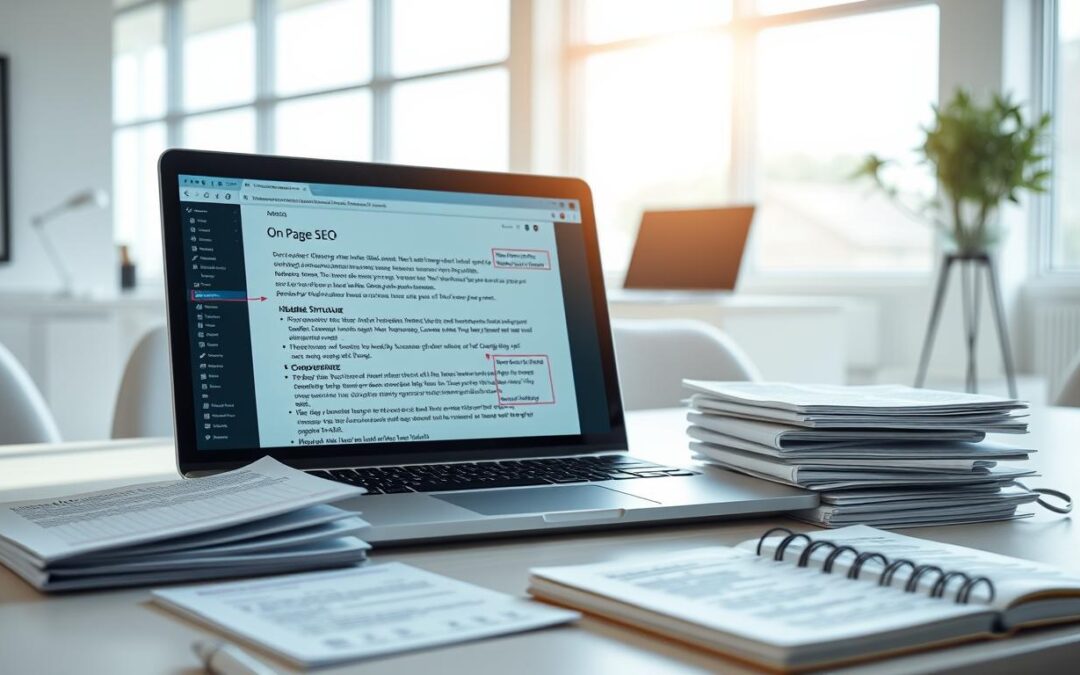Are you struggling to get your website noticed online? Are you wondering what it takes to boost your search engine rankings? We’re here to guide you through the process. On-page optimization is key to improving your website’s visibility. It’s not just about tweaking a few elements. It’s about optimizing many elements to make your site more search engine friendly.
By understanding and using effective SEO optimization tips, you can boost your online presence. This means creating content that appeals to both search engines and people. It also means making sure your site is easy to use. For more help, check out Google’s SEO starter guide for valuable tips.
Key Takeaways
- Optimize website elements for better search engine rankings.
- Craft content that resonates with both search engines and human readers.
- Ensure a seamless user experience to enhance online presence.
- Use effective SEO optimization tips to drive more traffic.
- Refer to authoritative guides for detailed SEO guidance.
What Makes On-Page SEO Critical for Your Website
On-page SEO is key to a good digital marketing plan. It helps your website rank better in search engines. By making your site better, we can get more people interested in what you offer.
The Impact of On-Page SEO on Search Rankings
On-page SEO makes it easier for search engines to get your site. This is important for your site to rank well. Good SEO techniques help your site show up more in search results.
| On-Page SEO Element | Impact on Search Rankings |
|---|---|
| Keyword Optimization | Increases relevance for search queries |
| Content Quality | Enhances user experience and engagement |
| Page Load Speed | Improves user experience and reduces bounce rates |
On-Page vs. Off-Page SEO: Understanding the Difference
On-page SEO deals with your website’s own elements. Off-page SEO looks at things like backlinks and social media. Both are important for a strong SEO plan. Knowing the difference helps us make your site better for search engines.
On-Page SEO Best Practices for Driving Organic Traffic
On-page SEO is key to a good digital marketing plan. It helps you get more organic traffic. By making your website better, you can rank higher in search engines and get more quality leads.
Conducting Effective Keyword Research
Keyword research is the base of on-page SEO. It’s about finding what people search for when they need what you offer.
Finding High-Value Keywords for Your Niche
To find great keywords, start with a list of relevant terms. Then, use tools to see how often they’re searched and how competitive they are. Conductor’s Academy has tips on making content that your audience will love.
Understanding Search Intent Behind Keywords
It’s important to know why people search for certain things. Are they looking for info, products, or services? Matching your content to their needs can really help your ranking.
Creating High-Quality, Relevant Content
Creating great content is vital for on-page SEO. Your content should be valuable, well-researched, and interesting. For more on using SEO in your content, see Zen9 Marketing’s guide.
| Content Characteristics | Best Practices |
|---|---|
| Relevance | Align content with user search intent |
| Quality | Ensure content is well-researched and engaging |
| Length | Comprehensive content performs better; aim for in-depth coverage |
Optimizing for User Experience Signals
User experience signals, like page speed and mobile-friendliness, are important for on-page SEO. Making these better can help users stay longer and improve your search rankings.
By following these on-page SEO tips, you can make your website more visible. This will help you get more organic traffic and grow your online presence.
Technical On-Page SEO Elements You Can’t Ignore
Technical on-page SEO is key to a website’s success. It affects how users experience your site and how search engines find it. By focusing on important technical aspects, you can boost your site’s ranking and attract more visitors.
Improving Page Load Speed
Page speed is vital for both users and search engines. A slow site can cause people to leave quickly, hurting your engagement.
Image Compression and File Optimization
Compressing images and choosing the right file formats can make your site load faster. Tools like TinyPNG help reduce image sizes without losing quality.
Leveraging Browser Caching
Browser caching stores often-used resources locally. This cuts down on repeat downloads, speeding up your site.
Mobile Optimization Techniques
Most web traffic now comes from mobile devices. Making sure your site works well on mobile is essential. Responsive design and mobile-specific tweaks can enhance both user experience and search rankings.
Creating SEO-Friendly URL Structures
Good URLs with target keywords help both users and search engines. Avoid long, complex URLs with unnecessary parameters.
| Technical Element | Impact on SEO | Best Practice |
|---|---|---|
| Page Load Speed | Improves user experience and search engine rankings | Optimize images, leverage browser caching |
| Mobile Optimization | Enhances user experience on mobile devices | Use responsive design, mobile-specific optimizations |
| URL Structure | Improves crawlability and user experience | Use descriptive, keyword-rich URLs |
Content Optimization Strategies That Boost Rankings
Effective content optimization can greatly improve your website’s search engine rankings. It drives more organic traffic. This is a key part of on-page SEO. It makes your content more relevant, visible, and easy to use.
Crafting Compelling Title Tags and Headlines
Your title tag is the first thing people see in search results. It’s key to whether they click on your page. Create attention-grabbing, descriptive, and keyword-rich titles that match your page’s content.
Writing Click-Worthy Meta Descriptions
Meta descriptions summarize your page’s content. They’re important for getting users to click through from search results. Well-written meta descriptions should be short, informative, and include the right keywords.
Strategic Keyword Placement Without Keyword Stuffing
Placing keywords strategically is vital for SEO. But do it naturally to avoid keyword stuffing. This can harm your rankings.
Optimal Keyword Density
Keep your keyword density between 1-2%. This ensures your content is relevant without seeming spammy.
Using LSI Keywords and Synonyms
LSI (Latent Semantic Indexing) keywords and synonyms help search engines understand your content. This boosts your content’s visibility for related searches and improves its semantic relevance.
For example, if your main keyword is “content optimization,” LSI keywords could be “SEO strategies,” “on-page SEO,” and “content marketing.” Adding these naturally can increase your content’s relevance and ranking.
By using these content optimization strategies, you can boost your website’s search engine rankings. This drives more organic traffic and improves your online presence.
HTML Elements That Strengthen Your SEO Foundation
HTML elements are key to your website’s success in SEO. They help improve your site’s structure, making it easier for search engines to find and understand. We’ll look at the importance of header tags, image alt text, and internal linking.
Hierarchical Header Tag Implementation (H1-H6)
Header tags are vital for organizing your content. Start with H1 for the main title, then use H2, H3, and more. This helps search engines see the importance and context of your content.
Image Alt Text and File Name Optimization
Optimizing images is key for better website accessibility and search rankings. Use descriptive alt text with target keywords and name files with relevant keywords. For example,
Internal Linking Best Practices
Internal linking helps search engines understand your site’s structure. Create topic clusters and use optimized anchor text. This improves both user experience and search engine crawlability.
Creating Topic Clusters
Topic clusters group related content together. This makes your content more relevant and authoritative to search engines. For more on content marketing, check out our guide.
Optimizing Anchor Text
Optimizing anchor text means using descriptive and relevant text for links. Mix branded and keyword-rich text to enhance user experience and search rankings.
| Best Practice | Description | Benefit |
|---|---|---|
| Hierarchical Header Tags | Structuring content with H1-H6 tags | Improves content readability and SEO |
| Image Optimization | Using descriptive alt text and file names | Enhances accessibility and search engine ranking |
| Internal Linking | Creating topic clusters and optimizing anchor text | Improves user experience and search engine crawlability |
Advanced On-Page SEO Techniques for Competitive Edges
Boost your website’s search engine ranking with advanced on-page SEO. It’s key to use strategies that make your site more visible and relevant. This will help you outrank your competitors.
Implementing Schema Markup
Schema markup is a tool that helps search engines get your content. It makes your site look better in search results and can increase clicks. For example, schema markup for reviews can show star ratings, making your site more attractive.
Optimizing for Featured Snippets
Featured snippets are a great way to get noticed in search results. To get them, create short, direct answers to user questions. Use lists or tables to make your content easy to read.
Enhancing Semantic Relevance with Entity SEO
Entity SEO makes your brand more credible to search engines. By showing expertise, authoritativeness, and trustworthiness (E-A-T), you boost your site’s relevance. For more on advanced SEO, check out https://phillipstemann.com/advanced-on-page-seo/.
| Advanced Technique | Description | Benefits |
|---|---|---|
| Schema Markup | Helps search engines understand your content | Enhanced SERP appearance, improved click-through rates |
| Featured Snippets Optimization | Creates concise, structured content for snippet eligibility | Increased visibility, boosted credibility |
| Entity SEO | Establishes brand credibility and semantic relevance | Improved search engine rankings, enhanced E-A-T |
Using these advanced SEO techniques can give you an edge. They help improve your website’s search engine performance. Stay competitive by using these strategies to attract more organic traffic.
Measuring Your On-Page SEO Performance
To see how well your on-page SEO works, you need to check it often. This helps you find what’s not working and fix it.
Essential Metrics to Track
It’s important to watch the right numbers to understand your SEO. Key ones are:
- Organic traffic
- Keyword rankings
- Page load speed
- Bounce rate and dwell time
Tools for Monitoring On-Page SEO Success
Using the right tools makes tracking your SEO easier. Some top ones are:
- Google Analytics
- SEMrush
- Ahrefs
Implementing Data-Driven Improvements
After you’ve looked at the data, it’s time to make changes. Look for patterns and what needs work. This might mean optimizing website content, speeding up pages, or tweaking keywords.
By always checking and tweaking your SEO, you can make your website better. This will help you rank higher in search engines.

Conclusion: Taking Your On-Page SEO to the Next Level
Business owners can make their websites more visible by using good on-page SEO. It’s key to know how to optimize for organic search. This helps bring in the right leads and meet digital marketing goals.
For SEO newbies, learning the basics is a good first step. Start with optimizing title tags, meta descriptions, and header tags. Also, create content that speaks to your audience.
To get even better, look into advanced techniques like schema markup and entity SEO. Backlinko’s guide on on-page SEO is a great resource. Keep improving your SEO to stay ahead and succeed in the long run.

